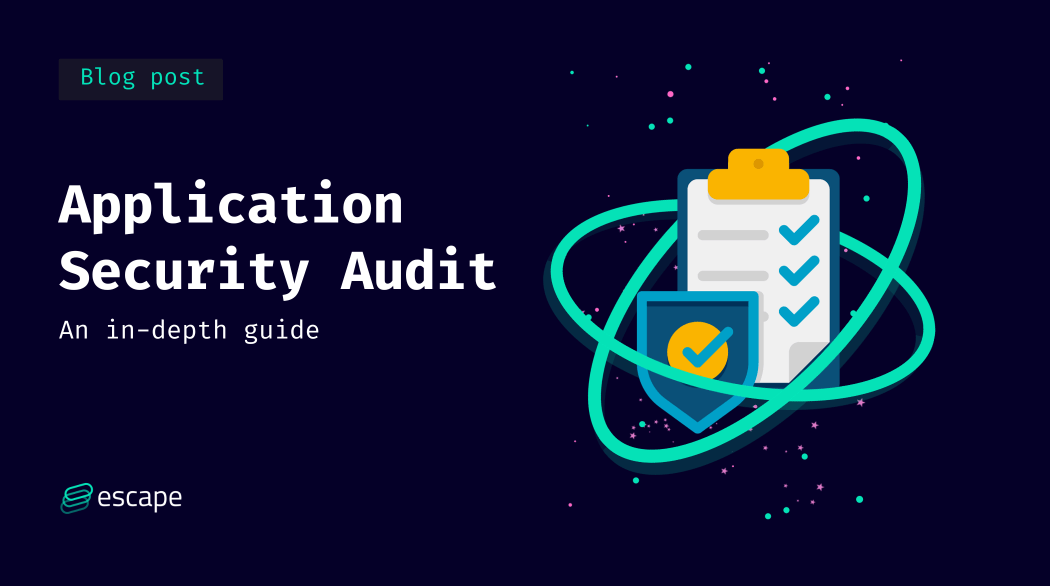Application security audit: an in-depth guide

Introduction
What are application security audits?
In information technologies departments, application security audits are systematic evaluations conducted to assess the security posture of an organization's applications.
Application security audits involve finding possible threats and determining the organization's attack surface. The different vectors that attackers can leverage to harm a corporation determine this scope.
Role of application security audits in risk management
By uncovering vulnerabilities, audits help organizations prioritize and implement necessary security controls, reducing the risks associated with potential attacks. The scope of these attacks is broad and encompasses leaks of sensitive data, including customer data, denials of service (DoS attacks), or performing unauthorized admin operations on behalf of regular users.
Auditing also plays a crucial role in ensuring compliance with industry standards and regulations, minimizing legal and reputational risks.
Application security audits: overall benefits
Alignment with regulatory compliance
Compliance standards provide a common framework for security guarantees between business partners. More than that, meeting a regulatory standard is a business leverage. These often are a prerequisite for conducting business with larger organizations. Failing to comply with a security standard can even bring legal exposure to the company in certain situations.
Organizations operate in industries with specific regulations and compliance requirements. For example, healthcare has its standard, HIPAA, that strongly focuses on implementing measures to guarantee customer data confidentiality. The European Union also enforces a compliance standard for data management named GDPR.
Application security audits help organizations meet these regulatory obligations by assessing the effectiveness of security controls, data protection measures, and privacy practices within their applications.
Benefits of regular application security audits
Organizations can demonstrate their commitment to meeting regulatory obligations and safeguarding sensitive information by conducting regular audits and implementing the necessary security controls. Also, most security frameworks provide requirements in recurrence for at least a part of their security controls.
For instance, the CIS framework for cloud infrastructure involves scheduled recurrent exercises for the company's disaster recovery plan.
By fostering a culture of security awareness within the organization, it can also stay ahead of evolving threats and emerging vulnerabilities, mitigating potential risks before they lead to security incidents or breaches.
The public is also sensitive to some of these standards (GDPR, for instance), and being secure is a branding asset.
Benefits of security audits within the Software Development Lifecycle (SDLC)
Security audits within the Software Development Lifecycle (SDLC) are essential to ensuring robust application security. By incorporating security audits at various stages of the SDLC, organizations can proactively identify and address security vulnerabilities early in the development process.
During the requirements gathering and design phases, awareness of regulatory guidelines helps define security requirements and incorporate them into application architecture.
Security audits focus on secure coding practices and adherence to coding standards in the development phase. Auditing the codebase helps identify vulnerabilities such as insecure input handling, injection flaws, or inadequate authentication mechanisms. Static code analysis and code review techniques assist in identifying and fixing such issues before they manifest into security vulnerabilities.
Every field of the application security landscape (supply chain, cloud infrastructure, application security, etc) has tools to integrate within the SDLC. Escape is one of them, focusing on API security and inventory management.
Planning and conducting an application security audit
Attack surface
The very first thing an attacker will attempt to steal is data. Most vulnerability issues regarding data security take the shape of one of the following:
- Data leaks in an application
- Insufficient access control regarding production data access from staff
- Inadequate or inexistent backup policies for data storage, missing classification of hosted data
Improper access control will also have consequences on the integrity of an application. A good access control policy involves both the application and the supporting technologies (cloud infrastructure, back offices, etc). Most improper access control configurations can lead to the following:
- Execution of unauthorized operations on forbidden parts of the system. An attacker could, for instance, hijack a connection for an admin panel to perform admin operations in the name of the hijacked connection.
- Access to unauthorized data, whether it comes from sibling data tenants (IDOR flaws, for instance) or another system (Cross-site scripting executions or XSS, for instance).
Finally, the whole toolchain used to develop the software is subject to various attacks and malicious injections. This scope is delimited by:
- The Software Supply chain (packages, docker images, whatever component that comes outside of the company)
- Infrastructure resilience & infrastructure as code (IaC)
- Monitoring of the above (audit logs, appropriate alerting)
Targeting a relevant threat surface
The list above is overwhelming, but the point of the threat surface assessment is to prioritize them.
- A small organization may want to protect data access and ensure basic security configurations, like the recurrent rotation of system credentials. It probably will only need to secure part of its supply chain (even though it has become much easier to control!).
- A larger organization will need to control the whole scope because most compliance frameworks are targeting most of these security scopes.
Shift-left is the industry's response not to compromise security: Automate everything regarding security. Doing so lets you detect potential threats as early as possible and train the whole organization to produce compliant software by default.
Finally, a good starting point for targeting the organization's needs in terms of security is to define a disaster recovery plan.
Involving staff in conducting the audit
Involving staff in the application security audit process is crucial for its success. Staff members possess valuable insights into the organization's applications and can provide critical context during the audit.
By involving staff in the audit, organizations can tap into their knowledge and expertise and thus tailor their audit to their business constraints.
Involving IT and Development Teams ensures the audit covers all relevant technical areas and produces actionable recommendations.
However, it would be a mistake to oversee the opinions of business stakeholders within the organization. Their involvement helps align the audit with business objectives and prioritize security efforts based on the significance of the applications to the organization and its customers.
Finally, involving the organization's security team ensures the audit aligns with established security policies, standards, and best practices for more giant corporations. Their expertise can help identify potential vulnerabilities, assess risks, and recommend appropriate security controls.
Common audit methods
- Code Development and Review: Ensuring secure coding practices and conducting code reviews to identify vulnerabilities and potential implementation flaws.
- Deployment and Configuration: Reviewing the configuration of the application and its underlying infrastructure to ensure proper security settings and access controls. Ops must focus intensely on this topic if the application's deployment is based on infrastructure as code (IaC) and even more when it involves possibly complex cloud solutions.
- Testing and Quality Assurance: Conducting security testing, such as vulnerability assessments, penetration testing (remote and physical for more giant corporations), and security scanning, to identify weaknesses and validate the effectiveness of security controls.
- Maintenance and Monitoring: Implementing processes for operational monitoring, patch management, and continuous security improvement, including regular audits to detect and remediate emerging vulnerabilities.
- It's important to note that the specific steps and methods for security audits may vary based on the organization's context.
Conclusion
Why should organizations conduct application security audits?
- Regular security audits are a mandatory step to ensure compliance with regulatory standards.
- Those standards are helpful to abide by because of their security components and because they unlock business potential by making the company eligible for more significant opportunities.
- Besides assessing the security of an application and the processes of the team behind it, you must evaluate the attack surface to decide precisely who to involve in the security audit and how to conduct it.
- Shift-left in application security allows to ensure compliance along the delivery of the application, instead of conducting an audit for it a posteriori
What to look for when choosing an application security audit vendor
A full application security audit is an enormous task to complete. You might need some help in the process. Many third-party vendors offer various solutions to cover the audit's different security scopes or components of a complex application.
The following presents some guidelines for choosing wisely a third-party security vendor.
- Research the vendor's reputation and look for references or case studies from their previous clients. It will give you an idea of their track record and customer satisfaction levels.
- Ensure the vendor has experience working in your industry or a similar one. It is crucial because different sectors have varying regulatory requirements, compliance standards, and specific security challenges.
- Tools and technology: Inquire about the vendor's tools and technology for assessments. Advanced scanning tools, vulnerability discovery techniques, and manual testing should be part of their arsenal.
You don't always need a dedicated third-party application security audit company. Some application security testing tools like Escape propose detailed overviews and reporting showing whether or not your application complies with common security standards, including OWASP TOP 10, PCI-DSS, WASC, and CWE.
Another important aspect is to choose a solution that would give you not only problems that you would need to fix but also guide you on how to fix them.
Prioritize experience in your specific technology and a customized approach to meet your unique needs.
🧑🎓 Want to learn more about application security? Check out the following articles:
